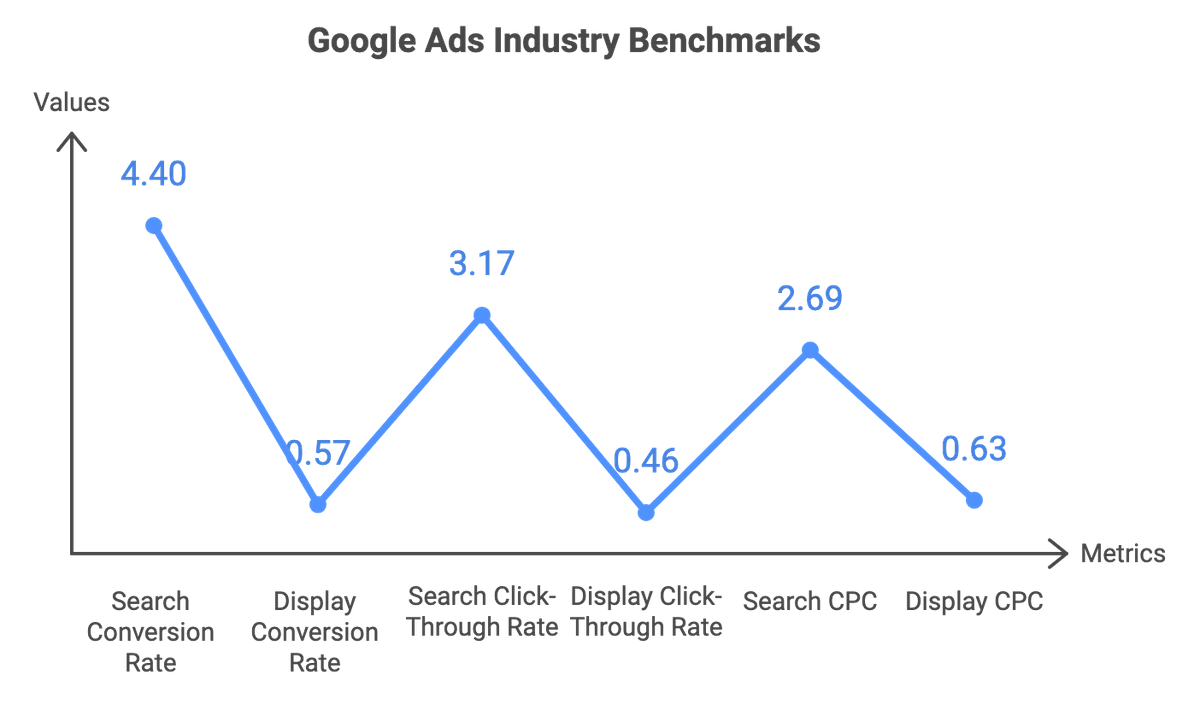How to Create a Winning Google Ads Campaign in 5 Easy Steps
By: Hayden Jarman

Google Ads is one of the most powerful tools for reaching potential customers when they’re actively searching for what you offer.
But here's the truth: simply creating a campaign and hoping for the best won't cut it.
To make your campaign truly successful, you need a clear strategy that covers everything from selecting the right keywords to optimizing your ad spend.
Today, I’m going to show you how to create a winning Google Ads campaign in five easy steps, optimized for 2024's digital advertising landscape.
In the next 5 minutes, you’ll have a clear roadmap that can help you maximize ROI and grow your business.
🤔 Which Google Ads Campaign Type is Right for You? 🔍
Table of Contents:
- Step 1: Set Clear Campaign Goals (Start with the End in Mind)
- Step 2: Perform Thorough Keyword Research (The Backbone of Your Campaign)
- Step 3: Write High-Converting Ad Copy (Hook Them Immediately)
- Step 4: Budgeting and Bidding Strategies (Make Every Dollar Count)
- Step 5: Monitor, Analyze, and Optimize (The Secret to Long-Term Success)
- Final Thoughts: The Path to a Winning Google Ads Campaign
- Additional Resources
Step 1: Set Clear Campaign Goals (Start with the End in Mind)
Before diving into your Google Ads account, you need to get laser-focused on your campaign’s goals.
Without clear objectives, it’s impossible to measure success.
Types of Campaigns You Can Run
Google Ads offers multiple campaign types, each with a different objective:
| Campaign Type | Purpose |
|---|---|
| Search Campaigns | Show text ads in Google search results |
| Display Campaigns | Display visual ads across Google's ad network |
| Video Campaigns | Reach users through YouTube and partner sites |
| Shopping Campaigns | Promote products in Google Shopping |
| Performance Max | Automate campaigns across all Google channels |
If you want to know more about different advertising options, check out this in-depth guide on paid media advertising to learn how Google Ads compares to other platforms.
Key Performance Indicators (KPIs)
Once you’ve selected your campaign type, establish the key performance indicators (KPIs) that will track your campaign’s success.
Common KPIs include:
- Click-through rate (CTR): How often people click on your ad
- Conversion rate: How many clicks turn into sales or leads
- Cost per acquisition (CPA): The cost of acquiring a customer
- Return on ad spend (ROAS): The revenue generated for every dollar spent
Let’s say you run an online store that sells fitness equipment. If your goal is to increase sales, your KPIs could include conversion rate and ROAS.
This helps you stay focused on measurable results.
Step 2: Perform Thorough Keyword Research (The Backbone of Your Campaign)
Keywords are what connect your business with potential customers.
The right keywords will bring the right audience to your site. The wrong ones will waste your budget on irrelevant traffic.
Using Google Keyword Planner
Google Keyword Planner is a free tool that helps you find relevant keywords for your campaign.
When conducting keyword research, consider:
- Broad Match: Shows your ad for any search related to your keyword.
- Phrase Match: Displays your ad for searches containing the exact phrase.
- Exact Match: Shows your ad only when someone searches for the exact keyword.
- Negative Keywords: Prevents your ad from appearing in searches that aren’t relevant.
Long-Tail Keywords
Long-tail keywords are longer, more specific phrases with lower competition.
Although these keywords tend to have lower search volume, they often yield higher conversion rates because they attract highly targeted users.
For example, if you own a landscaping business, instead of using the broad term "landscaping services," you might target the long-tail keyword "affordable residential landscaping services in Wilmington."
Want More Help with Google Ads?
If you're new to Google Ads, you might find this complete guide to Google Ads helpful.
It walks you through everything from setting up your first campaign to optimizing for the best results.
Step 3: Write High-Converting Ad Copy (Hook Them Immediately)
Your ad copy is what convinces users to click on your ad instead of your competitor’s.
Effective ad copy is clear, concise, and action-oriented.
How to Create Compelling Ad Copy
Here are the core elements to focus on when writing ad copy:
- Keyword Optimization: Your target keyword should appear in both the headline and description.
- Strong CTAs: Encourage users to take action with phrases like “Shop Now” or “Get a Free Quote.”
- Unique Selling Proposition (USP): Highlight what sets your product or service apart from the competition.
Responsive Search Ads (RSAs)
In 2024, Responsive Search Ads (RSAs) are key to ad success.
These ads allow you to create multiple headlines and descriptions, and Google will automatically test different combinations to find the best performers.
This automated approach improves efficiency and performance over time.
Example of Ad Copy:
Headline: “Affordable Landscaping Services | Free Consultation Available”
Description: “Looking to upgrade your backyard? Our expert team offers affordable landscaping solutions. Call today for a free consultation!”
Leverage Ad Extensions
Ad extensions can boost your ad’s visibility without increasing the cost.
Here are some must-have extensions for 2024:
- Sitelink Extensions: Link to additional pages on your website.
- Callout Extensions: Highlight key offers or services.
- Structured Snippets: Provide additional details about your business.
For a deeper dive into comparing different ad strategies, you might also want to check out this comparison of Facebook Ads vs. Boosted Posts, which can help you understand other platforms in the context of paid media.
Step 4: Budgeting and Bidding Strategies (Make Every Dollar Count)
Getting your budget and bidding strategy right is essential for ensuring you don’t overspend—or worse, underspend—and miss out on potential conversions.
Daily vs. Lifetime Budgets
- Daily Budget: The amount you’re willing to spend per day. This works well for ongoing campaigns.
- Lifetime Budget: The total amount for the entire campaign duration. Ideal for short-term, high-impact promotions.
Smart Bidding Strategies
Google’s Smart Bidding strategies are all about automation and optimization. In 2024, the best strategies include:
- Target CPA: Google automatically adjusts bids to get as many conversions as possible at a set cost per acquisition.
- Maximize Conversions: Focuses on driving the most conversions within your budget.
- Target ROAS: Adjusts bids to maximize revenue based on a specific return on ad spend goal.
Example:
If you’re running an e-commerce business, the Maximize Conversions strategy might be your best bet, helping you generate the most sales possible within your budget.
However, if profitability is your priority, you may opt for Target ROAS to ensure you’re getting a good return on every dollar spent.
Step 5: Monitor, Analyze, and Optimize (The Secret to Long-Term Success)
The real power of Google Ads comes from ongoing optimization.
Once your campaign is live, you can’t just set it and forget it—you need to constantly monitor and make adjustments to improve performance.
Key Metrics to Watch
- Quality Score: Google’s rating of your ad relevance, keywords, and landing page quality.
- Conversion Rate: The percentage of users who take your desired action.
- Cost Per Click (CPC): How much you’re paying for each click.
- Click-Through Rate (CTR): How often users are clicking on your ads.
Optimization Tools
- Google Ads Editor: A free desktop tool for managing your campaigns in bulk.
- A/B Testing: Test different variations of your ads to see what works best.
- Google Analytics: Use this to track post-click performance and conversions.
Pro Tip: Leverage Remarketing
Remarketing allows you to show ads to users who have already interacted with your website.
These users are more likely to convert, making remarketing a highly effective strategy for boosting ROI.

| Metric | Industry Benchmark |
|---|---|
| Conversion Rate | 4.40% (Search), 0.57% (Display) |
| Click-Through Rate | 3.17% (Search), 0.46% (Display) |
| CPC | $2.69 (Search), $0.63 (Display) |
Final Thoughts: The Path to a Winning Google Ads Campaign
Creating a winning Google Ads campaign isn’t rocket science, but it does require a solid strategy.
By following these five steps—setting clear goals, performing thorough keyword research, writing compelling ad copy, optimizing your budget and bids, and continually monitoring performance—you can create a high-performing Google Ads campaign in 2024.
If you’re ready to dive deeper into paid media strategies and get the best possible results, check out our complete guide to Google Ads for more advanced tips.
Additional Resources
For readers looking to dive deeper into Google Ads strategies and performance, here are some valuable resources to help enhance your campaign knowledge:
- Google Ads Statistics & Trends for 2024 – A detailed Reddit discussion in the r/Analyzify community that provides an in-depth look at Google Ads metrics and industry trends.
- 2024 Google Ads Statistics – A comprehensive article from Analyzify highlighting the latest Google Ads statistics, complete with data visualizations and key insights.
- B2B SaaS Google Ads Stats & Benchmarks – This resource from PoweredBySearch focuses specifically on B2B SaaS companies and their Google Ads performance.
- Google Ads Statistics Blog – WebFX compiles a wide range of Google Ads statistics, offering insights across multiple industries.
- Tips for Optimizing Google Ads Campaigns – Learn effective strategies for improving your Google Ads campaigns from this article on Seven Atoms' blog.
- PPC Statistics Overview – Sixth City Marketing provides useful data on PPC, including Google Ads, helping you understand trends and performance benchmarks.
- Are Google Ads Effective? – Single Grain’s blog post delves into the effectiveness of Google Ads, offering statistics and case studies on its impact.
- Google Shopping Ads Statistics for 2024 – Bind Media focuses on the latest insights related to Google Shopping Ads, with data tailored to 2024 trends.
Need Help with Your Google Ads Strategy?
If you’re looking to optimize your Google Ads campaigns or need guidance to get the best results, reach out to the team at BlueTone Media.
Our experts are here to help you navigate Google Ads and maximize your return on investment!
Related Posts:
- Understanding Google’s Local Pack: How to Get Featured
- Google Business Profile FAQs: Everything You Need to Know
- The Best Google Ads Extensions to Boost Your Click-Through Rates
- How to Leverage Facebook Groups for Local Business Leads
- How to Use AI to Write Better Social Media Captions
- How to Optimize Google Reviews to Attract More Customers
- LinkedIn for B2B Marketing Success
- How to Conduct a Social Media Audit (w/ "Audit Readiness" Quiz!)
- Creating a Content Calendar for Consistent Posting
- The Importance of Mobile Optimization in 2024
- Data Privacy Regulations: What Marketers Need to Know
- The Role of Chatbots in Enhancing Customer Service
- SEO for Small Business: The Ultimate Guide to Getting Found Online
- The Role of Keyword Clustering in Modern SEO

